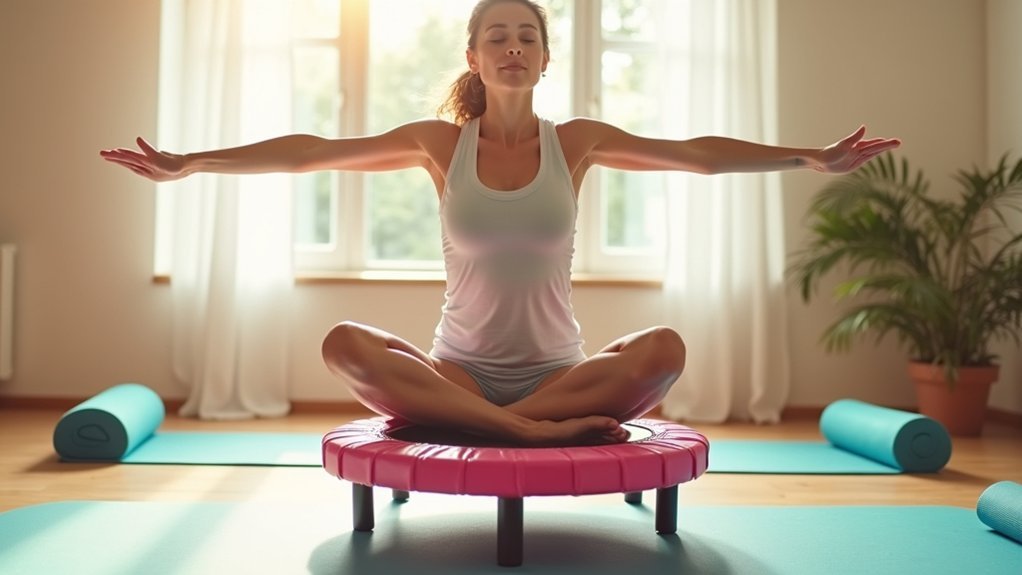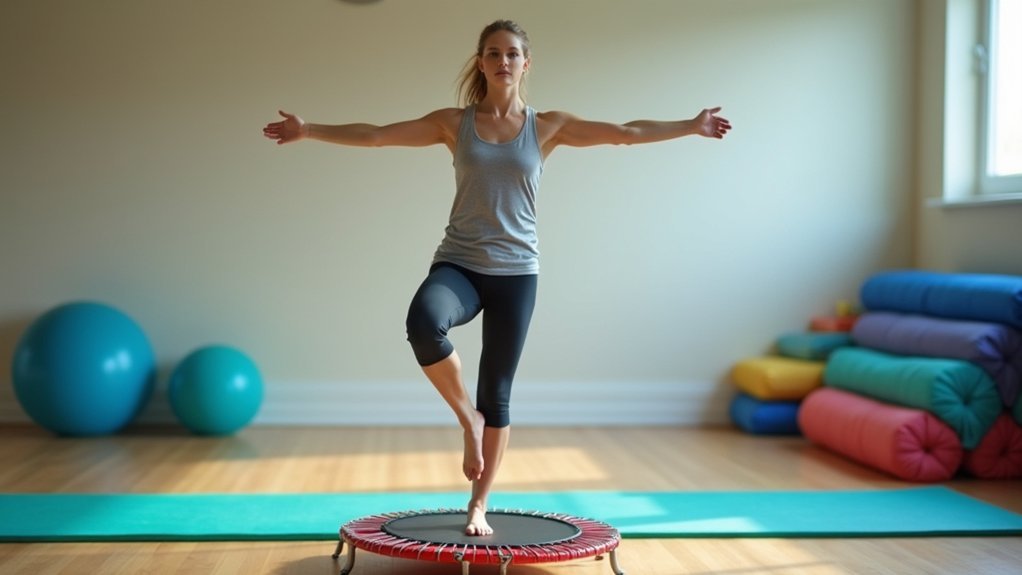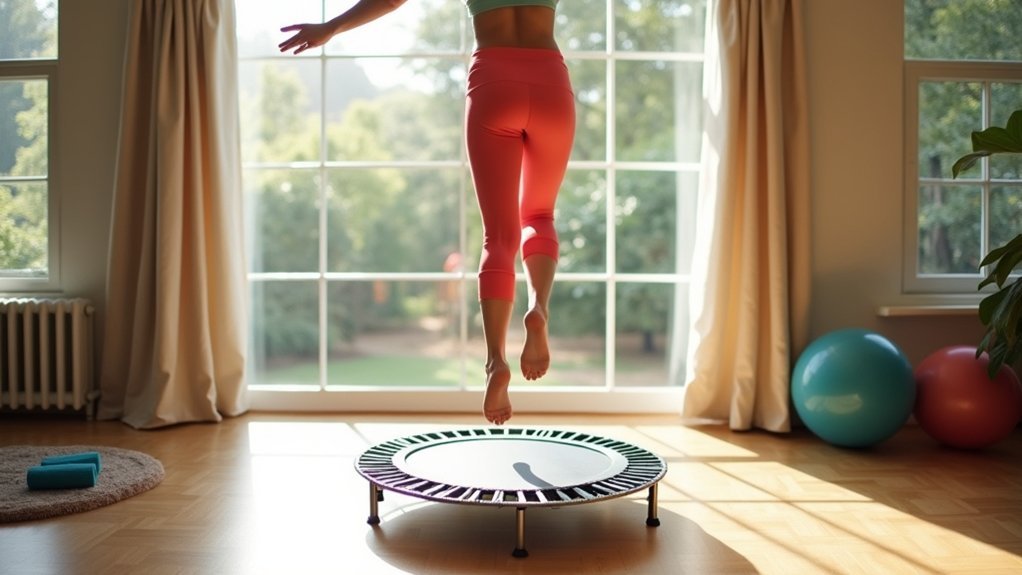Mini trampoline exercises offer excellent balance rehabilitation through low-impact movement. Try gentle weight shifting, single-leg balance holds, seated bounces, heel-toe rocking, modified marching, circular bounces, partner-assisted challenges, directional changes, and eyes-closed balance work. These exercises strengthen your core, improve proprioception, and enhance stability while minimizing joint stress. The bouncy surface creates just enough instability to challenge your balance systems while supporting your recovery journey.
Gentle Weight Shifting for Early Recovery Stability

When recovering from an injury or surgery, regaining your balance becomes an essential milestone on the path to full mobility. Gentle weight shifting exercises on a mini trampoline offer an ideal starting point, engaging your core muscles without excessive strain.
Begin by standing on your rebounder with feet hip-width apart. Slowly shift your weight from side to side while maintaining a slight bounce. This low-impact movement enhances stability and coordination while improving proprioception—your body’s awareness of its position in space.
These exercises don’t just build balance; they activate your lymphatic system, promoting detoxification and improved circulation.
Research confirms that this approach reduces fall risk for those recovering from orthopedic injuries, making it a safe, effective way to rebuild confidence in your movements.
Single-Leg Balance Holds on the Mini Trampoline
Three powerful benefits emerge when you progress to single-leg balance holds on your mini trampoline.
First, you’ll challenge your stability systems while activating core muscles, improving proprioception and coordination.
Second, this exercise strengthens the muscles surrounding your ankles and knees, making it ideal for rehabilitation and injury prevention.
To perform this exercise, stand on one leg with a slightly bent knee. Hold the position for 15-30 seconds, gradually increasing duration as you build strength.
Focus on engaging the core while maintaining balance—this simultaneous effort stimulates your lymphatic system, supporting overall health and recovery.
As you practice single-leg balance holds regularly, you’ll notice enhanced stability that transfers to daily activities and sports performance, making this mini trampoline exercise particularly valuable for long-term functional improvement.
Seated Bounce Progression for Core Strength

Five key advantages make seated bounce progression an excellent starting point for mini trampoline exercise, especially if you’re recovering from injury or have limited mobility.
This low-impact technique allows you to strengthen your core without stressing your joints while improving stability and balance.
Begin with gentle, controlled bounces while seated firmly on your mini trampoline. Focus on engaging your deep core muscles with each small movement.
As your confidence grows, gradually increase your bounce intensity and incorporate arm movements—reaching overhead or side to side—to challenge your coordination and further activate your core.
You’ll notice improvements in your overall stability with regular practice, creating a solid foundation for more advanced exercises.
This progression builds functional strength that translates directly to everyday movements.
Controlled Heel-to-Toe Rocking Movements
Controlled heel-to-toe rocking on your mini trampoline builds essential balance skills through proper weight shifting and gentle movements.
You’ll notice significant improvements in stability and proprioception as your body learns to recover from slight imbalances in this forgiving, low-impact environment.
Start with small, deliberate rocks holding a support if needed, then gradually increase your range of motion as your confidence grows.
Proper Technique Essentials
The foundation of effective mini trampoline balance training lies in mastering controlled heel-to-toe rocking movements. When performed correctly, these motions engage your core and activate stabilizing muscles, increasing proprioception and coordination.
Maintain proper alignment by keeping your spine straight and shoulders relaxed while shifting weight deliberately from heels to toes.
For maximum benefit, follow these key technique points:
- Stand with feet hip-width apart, core engaged, and gaze forward to establish proper alignment.
- Rock slowly from heels to toes, holding each position momentarily to challenge balance.
- Add gentle arm movements (reaching forward or sideways) to enhance coordination while maintaining stability.
Practice these movements for 1-2 minutes per session to strengthen ankle and foot muscles, improving overall balance and muscle strength during your recovery journey.
Balance Recovery Benefits
When recovering from balance-related challenges, heel-to-toe rocking exercises on a mini trampoline offer remarkable rehabilitation potential. You’ll improve proprioception—your body’s sense of position—while activating key stabilizing muscles that support better coordination.
| Benefit | How It Helps Your Recovery |
|---|---|
| Fall prevention | Enhances body awareness through weight shifting |
| Ankle stability | Strengthens supporting muscles around joints |
| Functional mobility | Builds confidence for everyday movements |
| Proprioceptive training | Retrains your body’s position sense |
| Rehabilitation progress | Provides measurable stability improvements |
These controlled movements are particularly valuable for rehabilitation since they create a gentle but effective challenge to your balance systems. By incorporating heel-to-toe rocking into your fitness routine, you’ll accelerate your recovery while building the stability foundation needed for returning to normal activities.
Gradual Progression Guide
Mastering heel-to-toe rocking exercises requires a thoughtful approach that respects your current ability level while challenging your balance systems.
Begin with controlled heel-toe rocking movements on your mini trampoline to improve balance through gentle activation of core muscles.
Your progression pathway should follow:
- Start with small weight shifts – focus on feeling your body’s center move forward and backward while maintaining stability.
- Increase rocking amplitude gradually – lengthen your movements as coordination improves.
- Add duration and repetition – work toward 10-15 continuous controlled rocks.
This gradual progression guarantees your stability systems develop properly during recovery.
As proprioception improves, you’ll notice enhanced coordination in daily activities.
Modified Marching for Proprioceptive Training
Engaging your body’s natural positioning system, modified marching on a mini trampoline stands as a fundamental exercise for proprioceptive development.
By alternately lifting your knees while maintaining foot contact with the rebounder, you’re challenging your body’s balance systems while strengthening your core and lower body.
What makes modified marching particularly valuable during recovery is its low-impact nature. You’ll experience minimal joint stress while maximizing muscle control benefits.
The gentle bouncing motion activates your lymphatic system, enhancing circulation and supporting natural detoxification processes.
For those rebuilding functional mobility after injury, this exercise offers the perfect combination of stability training and coordination enhancement.
You’ll develop greater body awareness as you practice, helping your nervous system reestablish those vital mind-body connections that form the foundation of confident, stable movement.
Cross-Body Pattern Exercises for Neural Coordination

Cross-body pattern exercises take your mini trampoline workout to a new neurological level.
When you engage opposite limbs simultaneously, you’re stimulating both brain hemispheres, enhancing neural coordination and proprioception. This targeted approach activates your core and stabilizing muscles, creating a foundation for improved balance and functional mobility during recovery.
Try these cross-body movements while gently bouncing:
- Opposite arm-to-knee touches – reach your right hand to your left knee, then alternate
- Cross-body punches with a slight twist – punch across your body while maintaining stability
- Diagonal arm and leg reaches – extend your left arm and right leg simultaneously, then switch
Regular practice of these exercises strengthens the neural pathways responsible for coordination, greatly improving your body awareness and reducing fall risk during rehabilitation.
Small Circular Bounces for Vestibular Adaptation
Small circular bounces on your mini trampoline can reset your vestibular system with gentle, controlled movements that challenge your inner ear in a manageable way.
Start with tiny circles, maintaining a slight bounce while moving your feet in a clockwise or counterclockwise pattern for 30-60 seconds before switching directions.
As your balance improves, you’ll benefit from increasing the complexity of your circular patterns—try figure eights or alternating between large and small circles to further enhance your vestibular adaptation.
Gentle Vestibular Reset
When your balance system needs recalibration, gentle circular bounces on a mini trampoline provide an ideal vestibular reset. This low-impact exercise stimulates your inner ear’s vestibular system, gradually helping your brain adapt to movement without overwhelming it.
You’ll notice improved balance and proprioception as your body becomes reaccustomed to spatial orientation.
The mini trampoline offers three key benefits:
- Engages core muscles for better stability during daily activities
- Creates gentle vestibular stimulation without jarring your joints
- Builds confidence through controlled, predictable movement patterns
For best recovery, practice these circular bounces consistently. Start with just a few minutes daily, then gradually increase as your balance improves.
The gentle nature of this exercise makes it accessible even when you’re experiencing dizziness or vestibular challenges.
Progression Through Patterns
As your vestibular system begins to adapt, you’ll want to introduce small circular bounces on your mini trampoline.
These gentle movements stimulate your inner ear while engaging stabilizing muscles around your ankles, knees, and hips—essential for improved balance and coordination.
Start with small, controlled circles and gradually increase the diameter as your confidence builds.
You’ll notice your proprioception improving with each session. During recovery, these circular patterns are particularly valuable because they challenge your balance systems without high impact.
The beauty of this progression lies in its adaptability.
Research shows these vestibular exercises greatly reduce fall risk while building core stability.
As you master basic circles, you can introduce figure-eight patterns or direction changes to further enhance your recovery journey.
Partner-Assisted Balance Challenges
Having a supportive partner by your side can transform your mini trampoline balance training from challenging to achievable. Partner-assisted exercises enhance your recovery journey by providing stability while you focus on improving balance and core stability.
When your partner holds your hand during one-legged stands, you’ll develop proprioception more confidently on the mini trampoline’s dynamic surface.
Try these partner-assisted balance challenges:
- One-leg balance – Stand on one foot while your partner provides finger-tip support, gradually reducing contact as your stability improves.
- Lateral weight shifts – Your partner applies gentle resistance as you shift from side to side, engaging your core muscles.
- Guided bouncing – Your partner provides feedback on your posture while you perform small, controlled bounces.
This collaborative approach builds motivation and accountability, making your balance training both safer and more effective.
Progressive Directional Changes for Spatial Awareness
Maneuvering through space with confidence requires more than simple forward movements on your mini trampoline. By incorporating progressive directional changes into your rebounder workout, you’ll challenge your body to adapt to shifting orientations, greatly improving balance and coordination.
Try lateral shuffles, diagonal jumps, and rotational twists to activate different muscle groups while enhancing proprioception and body awareness. These movements simulate real-life scenarios, boosting your agility and responsiveness to directional shifts.
Research confirms that these exercises reduce fall risk, especially for older adults and those in recovery. Regular practice develops physical stability that translates to better performance in daily activities and sports.
Your spatial awareness improves as your body learns to anticipate and adjust to changing environments—a vital skill for long-term balance confidence.
Eyes-Closed Balance Exercises for Sensory Integration
When you close your eyes during mini trampoline exercises, your body’s balance system undergoes a profound recalibration.
Without visual cues, your proprioception kicks into high gear, forcing your core and lower body muscles to work harder for stability. This sensory integration challenge is particularly valuable during rehabilitation or for those looking to improve functional mobility.
Try these eyes-closed exercises to enhance your coordination:
- Single-leg stands – hold for 15 seconds on each leg while maintaining minimal bounce
- Gentle marching – lift knees slowly while focusing on the trampoline’s subtle shifts beneath you
- Small heel-to-toe steps – pretend you’re walking an invisible tightrope across the trampoline surface
You’ll notice improved balance in daily activities as your brain learns to process sensory information more efficiently, reducing fall risk and enhancing overall stability.
Frequently Asked Questions
Is a Mini Trampoline Good for Balance?
Yes, a mini trampoline is excellent for your balance. You’ll strengthen core muscles, improve coordination, and develop proprioception while exercising on its forgiving surface. It’s a safe way to build stability for daily activities.
What Is 10 Minutes on a Rebounder Equivalent To?
Ten minutes on a rebounder equals running at 6 mph or cycling at 14 mph calories-wise. You’ll get cardiovascular benefits similar to brisk walking while enjoying the joint-friendly, full-body workout that enhances lymphatic circulation too.
How Can I Improve My Trampoline Balance?
To improve your trampoline balance, engage your core muscles, practice basic movements like walking in place, perform weight shift exercises, and gradually progress to dynamic movements. Using safety handles or exercising with a partner helps build confidence.
Does Rebounding Flush the Lymphatic System?
Yes, rebounding does flush your lymphatic system. When you bounce, you’re creating gravity shifts that stimulate lymph flow throughout your body, helping remove toxins and waste while supporting your immune function effectively.
In Summary
You’ve got everything you need to begin your recovery journey on the mini trampoline. Start with the gentlest exercises and gradually progress as your balance improves. Remember, consistency is key—even just 5-10 minutes daily will yield noticeable results. Always prioritize safety by having support nearby when needed. With practice, you’ll rebuild your confidence and stability while actually enjoying the recovery process.





Leave a Reply